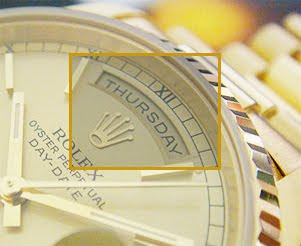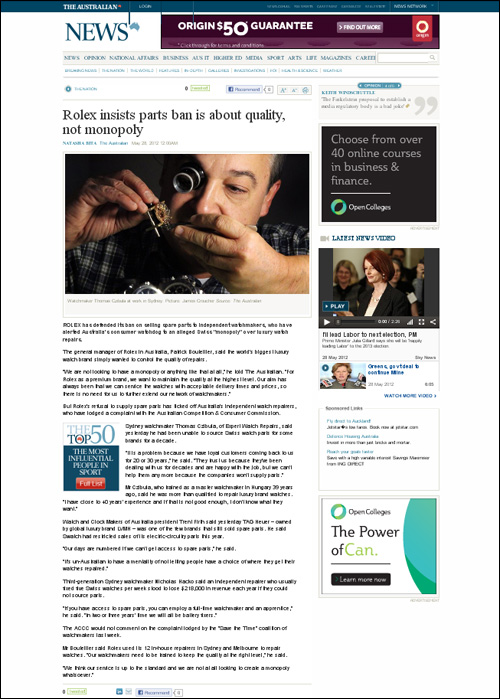Part 1.
I love my Holden Barina.
I got it new in 1997. Actually we had bought it just a few days after my wife brought home our baby boy from the hospital. On weekends, I would fit in a baby seat and we would drive along the coast. Monday to Friday, the Barina was used for business - if you lowered the front passenger seat
and folded over back seat, you can fit in a full-length English long case clock!
Most customers would just shake their heads in disbelief. Yes, you can say I am sentimentally attached to my little Holden. Almost 15 years later, it still goes like a rocket.
Oh yes, it is soon due for new brake pads. The search for new pads started with a visit to the Holden website. From there I got the phone number of
an authorized Holden parts supplier.
"Hi - do you still supply brake pads for a 1997 Barina manufactured in Spain? "
"Sure do. In stock. $78".
"$78 a piece?"
"No, $78 for a set of four."
"Fantastic. But just to make it clear, I am not in the car business..."
"Sorry?" asked the salesman-
"I said, I am not a car mechanic. Would you still sell the parts to me?
"We sell parts to anyone!"
"And I guess you want my old pads returned to you, right?"
"No mate, just chuck 'em in the rubbish bin (laughing)"
"...and do you need my car rego plates, or my drivers license?"
"No, just your VISA numbers. That's all."
"Great. But for your information, I intend to take my car to my next door neighbour,
he is going to install the pads..."
"That's fine, good for you. Now, can I get your card details so we can get this sale under way?"
I also wanted to tell him that my next door neighbour is not a car mechanic either but he was not really up for a chat. Anyway, I got my pads the next day in the mail.
While on Holden's website I also learned that Holden is in partnership with a third-party spare parts supplier which offers a range of parts to suit
their vintage models. ("Restoration Parts are often made from the original tooling and are as close to the originals as possible.")
I happily left Holden's website under the impression that Holden is a business that cares for their customers.
If you are a young couple expecting baby and looking for a car, go Holden like we did.
Good car, good memories.
Part 2.
Some of my long time subscribers are well aware that I am very passionate about my hobby. I LOVE my radios. After a long day behind a bench or in front of a computer, sanity is restored the moment I put headphones on and flick the switch of trustworthy ICOM.
This morning, I received an email from a fellow radio nutter. "The latest model of ICOM transceivers is now coming with newly designed transmitter amplifier. They will be using the most advanced gold metallized N-channel MOS field-effect RF power transistor".
Wow, that was cool news indeed.
But then I got worried - I love to repair my own radios, and while I rarely need to replace output transistors, the question was, would I be able to obtain such a very special component if I ever needed one? ICOM is Japanese radio manufacturer and amateur radios are just a part of a large Corporation which also supplies equipment to military, marine and avio users including the US Marine corp! Surely they would be very protective of their latest technology?
I was wrong once again.
A visit to ICOM's web page revealed that I have nothing to worry about: The Japanese were more than happy to tell everyone that the latest power amplifying device actually comes from STMicroelectronics, an Italian-French company, and that the component number is STAC2942. Another quick search revealed that while this component was only manufactured a couple of years ago, it is readily available from wholesalers everywhere - for just $120. Or for $90 on eBay!
If I ever needed replacement - or a truck load of them - I would have no problems fixing my latest model Japanese radio.
Yes I love my radios, and I will remain loyal to my favourite Japanese brand because
my brand respects me and my hobby.
Part 3.
This Monday I need to deliver two sets of news. Both bad.
Right in front of me, on my work bench, I have two watches belonging to customers, which have been sitting there for some time now. One is a lady's gold and steel watch, the other is a gent's diver's timepiece. The first one belongs to a lovely lady who has been my good customer for many years. Her watch needs a new circuit. A fifteen minute job which requires removing 4 screws and fitting a new battery. The second watch belongs to a guy whom I have never met, but was described as a massive gym junkie. Another easy job - his watch needs a new winding crown and a rubber seal.
So here I am, staring at two "dead" watches, trying to solve an unsolvable problem: How to repair them without spare parts? Yes, you guessed right - both watches are Swiss made and no, I have no access to those parts. Both watches are over 20 years old. Both customers left them with me in good faith, expecting a hassle free, straight forward repair.
Yet the only thing I can deliver on Monday is "Sorry I cannot help you."
I really hate those phone calls:
"Aren't you a watchmaker? So you don't know how to fix them? You don't have parts? Why? So now I have to waste my time once again coming to your shop to pick up my watch? Where do I take them now? How much is THAT going to cost me? Why does it take 3 month to do a 15-minute job? Why can't you do it? Why can't YOU get parts?...."
Quite frankly I am sick of explaining how little I can do without access to Swiss 'brand name' spare parts. It is painful and humiliating. It is frustrating. I am losing time, money and reputation. I am losing my best customers. it is as simple as that: once you say NO to a customer, that customer will never come back to you. There will be no referral, no 'job well done' feedback, no income.
As my 14 year old boy said: "It sucks to be you, dad! "
Yes, it sucks to be a watchmaker.
It sucks to be an Australian watchmaker who pays tax to the Australian Government yet is unable to fix a watch for an Australian customer because someone out there, in Switzerland, has taken full control over our lives.
And what sucks the most is that I cannot even name the brands which are depriving Australian watchmakers of their basic right to earn income - without being sued in AUSTRALIAN Court!
Part 4.
Apparently, the key reason why most Swiss brands refuse to sell watch parts to independent Australian watchmakers (and American, British, Norwegian
Italian, French and every one else) is this:
We, the independents, are not capable of handling Swiss watches.
We are somehow inferior, uneducated and inexperienced.
We are also unwilling to invest in modern tools and equipment.
Or something along those lines.
15, 35 or 40 years of repairing Swiss watches is still not good enough. The fact that we can actually repair far more complex watches than the majority of what they sell is irrelevant.
The fact that most of us are European trained, second, third or fourth generation watchmakers is also irrelevant.
My grandfather is now 92 years old and he still repairs clocks and watches.
He was a master Watchmaker before WW2. One vivid memory from my earliest childhood is a pile of watch crowns, metal bracelets, plexi glasses and other spare parts which he used to bring in suitcases from Switzerland from his parts buying trips.
Back in the 60s, 70s and even the 80s getting a spare part for Swiss watches was as simple as getting brake pads for a Holden. The Swiss brands needed us, and they needed us desperately to service their millions of watches.
The independent watchmakers were in business a long time before the Swiss even got into watches!
The reason why Australian independent watchmakers are cut out, pushed away and left to "starve to death" is this: Swiss corporate greed. We all know that.
So please, Swiss brands, let us preserve some of our dignity. Don't call us incompetent. Stop telling your customers that "taking your watch to an independent watchmaker is risky because they can't fix it."
The only reason why we are unable to repair your watches is because you REFUSE to supply parts. It's as simple as that. Not the other way around.
Quite frankly, a battery or circuit replacement in a Swiss watch is something we don't even consider as watchmaking. Even an overhaul on your "super duper" automatic movement is something we can do while blindfolded.
It's kids stuff to us.
When a customer brings a watch to you with a broken balance staff, you replace the balance wheel completely. We replace the balance staff only. When the watch is rendered by you as 'beyond repair, no parts available'
we get our 60 or 100 years old lathe and we turn the staff. We make one from a steel rod, by hand, the old fashioned way. When you run into a problem you cannot solve (on your own watch!) you replace the entire mechanism. Instead, we look for the problem - yes this is time consuming, but extremely satisfying - and we solve it. We get a kick out of repairing stuff you cannot or don't know how to repair!
And this is just a beginning. Some of our members, the independent watchmakers of Australia are capable of much more. They can restore even the most complex Swiss timepieces ever manufactured. They can manufacture parts which are completely missing, cut wheels and pinions. They are capable of restoring some of the most magnificent timepieces ever manufactured: English and French clocks, American railroad pocket watches, ship chronometers.
Do your watchmakers know how to make a detent for a chronometer escapement by hand? Have YOU ever tried to make one? How many of your "in house trained repairers," whose job is to swap a quartz movement, have even seen the fusee chain? How many of them can explain what the difference between the tick and tock sound is, what a poise error is or even the relationship between amplitude and timekeeping?
Or let me be just a touch more personal: how many of your AD (Authorized dealers whom you also call 'authorized service centers' for your brand when in reality they are just administrative operators) have even the simplest timing machine on premise? How many of those who you have allowed and authorized to sell $50,000 or $500,000 watches would have the slightest
clue about what makes those watches tick?
Once again, you are trying to pull out that old trick of Swiss corporate mastery. You know so well that refusal to sell spare parts to independent repairers is in breach of European competition rules and US anti-trust law. Australian consumer law is no different. But it looks like you simply don't care.
Either way, our message is simple: don't ever call us - the Australian watchmakers - incompetent or incapable. Because you may find out that one day when we are all gone, the table will turn around and the watch owners, YOUR customers, will say: it sucks to be you.











